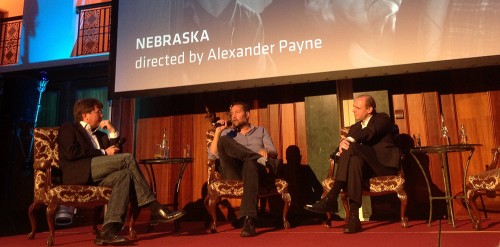 Reflecting its long-running association with the Berlin International Film Festival, yesterday ARRI hosted a well-attended Berlinale event at the city’s famous Hotel Adlon with cinematographer Phedon Papamichael, ASC, who recently used ARRI ALEXA cameras and the ARRIRAW format to shoot the anamorphic feature films Nebraska and The Monuments Men.
Reflecting its long-running association with the Berlin International Film Festival, yesterday ARRI hosted a well-attended Berlinale event at the city’s famous Hotel Adlon with cinematographer Phedon Papamichael, ASC, who recently used ARRI ALEXA cameras and the ARRIRAW format to shoot the anamorphic feature films Nebraska and The Monuments Men.
Stephan Schenk, ARRI’s General Manager – Business Unit Camera Systems, and Henning Rädlein, Head of Digital Workflow Solutions, led the discussion with Papamichael, who first used the ALEXA camera on 2012’s This is 40. The cinematographer noted, “After that experience I actually bought an ALEXA myself, because it seemed to me that whatever might happen with technology, this camera would always be good enough for theatrical release feature films.”
Nebraska, directed by Alexander Payne, has been nominated for six Academy Awards, including Best Picture and Best Achievement in Cinematography. Despite a relatively low budget of $12 million, ARRIRAW was chosen by the filmmakers because it brought significant production value, while the ALEXA’s unique 4:3 sensor assisted the anamorphic capture. Papamichael added film grain to his black-and-white images in post, emulating the look of 1970s films such as Paper Moon and The Last Picture Show, and commented on stage, “Black-and-white is actually easier to shoot than color, and a lot of fun, because you can do things that just wouldn’t work in color.”
Papamichael has also stated how the compact ALEXA M model helped him on the movie: “Nebraska required extensive car scenes, but we didn’t want to use a process trailer and an insert car. The ALEXA M permitted easier shooting inside vehicles and rigging through windows. Often the M head was on a slider in the back seat of the hero vehicle or mounted on a leveling head on the passenger side. Having this smaller setup allowed us to move quickly and gave us an intimacy with the characters in the car.”
During the discussion about The Monuments Men, director George Clooney’s highly anticipated WWII drama, Papamichael screened some of his camera tests to help explain how and why he combined ALEXA digital cameras with ARRICAM film cameras, and also mixed anamorphic lenses with spherical ARRI/ZEISS Master Primes, all provided by ARRI Rental in Germany, where most of the shoot took place. He noted, “Clooney agreed to use ALEXA after we shot these tests – he’d also used it a bit on Argo, which he produced, so the ice had been broken. I guess with ALEXA we could move a little faster and sometimes use a bit less light. Also, when you have the lighting visible on a monitor, you can make decisions and adjust it as you go along.”
Talking of the specific cameras he used on the film, Papamichael has stated, “The ARRICAM Lite is a very practical camera; we did a lot of Steadicam and handheld work on the film, and it’s very good for that. And of course having the ALEXA with a full-size 4:3 sensor was necessary because we were using the anamorphic format. We recorded ARRIRAW and it gave us very good results – very high quality – so cutting between the two formats was seamless.”
When asked at ARRI’s event how he felt about the advance of digital technology and the comparisons between film and digital, Papamichael commented, “I come from a time when film stocks didn’t actually have huge dynamic range, so for me the ALEXA is an improvement in this area. And in terms of resolution I personally just don’t need or want any more – that’s why I bought an ALEXA. I know a lot of other cinematographers feel the same way and are pulling back from this continual advance in resolution and sharpness; we have to shoot movie stars and too much sharpness simply doesn’t help.”
Speaking of the choice of format on these two feature films, Papamichael noted, “Anamorphic is just a beautiful format and I love composing in that wide aspect ratio.”
When quizzed about the new ARRI/ZEISS Master Anamorphic lenses, which he has had the opportunity to test, he commented, “They’re T1.9 and they look incredible even wide open, which is where a lot of other anamorphic lenses fall apart. With the Master Anamorphics there isn’t that fall-off – you can put a face right in the corner of the frame and it will be sharp.”
